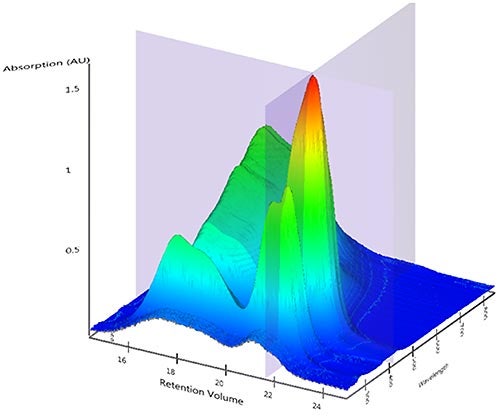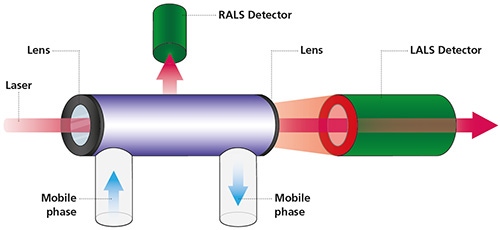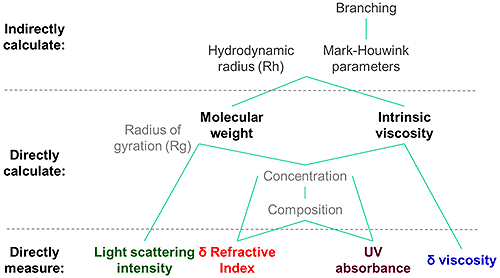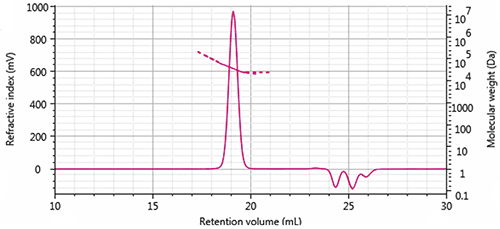OMNISEC REVEAL is the new top-of-the-range gel-permeation/size-exclusion chromatography (GPC/SEC) multi-detector module from Malvern. It combines refractive index, UV/Vis absorbance, light scattering and viscometer detectors to measure concentration, molecular weight and intrinsic viscosity with unparalleled sensitivity and accuracy as part of a GPC/SEC system. OMNISEC REVEAL is available as a detector-only option, which can be connected to any GPC/SEC system. Alternatively, it forms part of a complete OMNISEC GPC/SEC system which includes OMNISEC RESOLVE, Malvern’s dedicated separations module. With OMNISEC REVEAL, any GPC/SEC system becomes a powerful tool for complete molecular characterization of synthetic polymers, natural polymers and polysaccharides, and proteins.
This technical note describes the system and explains how OMNISEC sets a new standard in molecular characterization.

|
OMNISEC REVEAL is an advanced detector module. It contains all four detectors in a single integrated unit. It can be run on its own as a plug-and-play detector when combined with any existing GPC/SEC system (simply connect flow to the inlet, an injection trigger and analogue signals) or as part of a complete system including OMNISEC RESOLVE, the chromatography module.
When running, all of the data from the current injection is stored on instrument. This means that should the connection between OMNISEC REVEAL and the PC be lost during acquisition, any data missed by the software is downloaded upon re-connection so the full chromatogram is saved. In this way, the risk of data loss from a loss of connection is greatly reduced.
OMNISEC REVEAL includes the following 4 detectors in series:
The differential refractive index detector is a robust design that places it as the very first detector with the others following in series. This maximizes the sensitivity of the other detectors, in particular, the viscometer, and helps to minimize the band broadening between the detectors, again improving measurement accuracy. Precise temperature control and high quality electronics all contribute to exceptional baseline stability improving sensitivity and accuracy of the concentration measurements.
The UV/Vis absorbance detector is a photo-diode array capable of making measurements from 190-900 nm and therefore covers the full UV and visible range. This widens the potential applications range to include samples such as polythiophenes which may absorb light outside the UV range.

|
The light scattering detector in OMNISEC REVEAL is the most sensitive on the market. Its sensitivity enables measurements of molecular weights as low as 200 Da or injection masses as low as 100 ng of material. This sensitivity enables it to measure low molecular weight samples; novel polymers with low dn/dc; or extremely small amounts of precious samples such as proteins.
The light scattering detector is a successful RALS/LALS design pioneered by Viscotek. The light scattering detector determine molecular weight by measuring the intensity of the light scattered by the sample. A RALS (right-angle light scattering) detector measures the scattered light at 90° and has excellent sensitivity due to its simple optical design. It can measure the molecular weight of molecules below approximately 10-15 nm radius. The LALS (low-angle light scattering) detector measures the scattered light at just 7°. A LALS detector can accurately measure the absolute molecular weight of all molecules without extrapolation or fitting of the angular data. The combination of RALS and LALS offers the sensitivity of a RALS detector with the accuracy of a LALS detector to offer excellent molecular weight measurements across the whole range addressed by GPC/SEC. The additional benefit of the RALS/LALS design is that the flow cell volume is just 18 µL. This minimizes band broadening and tailing (dispersion) that occurs between detectors.

|
The viscometer in OMNISEC REVEAL is based on the original Wheatstone bridge design patented by Viscotek but has been reengineered to improve its usability and performance. The new viscometer includes two major improvements over previous designs. The first is the exchangeable viscometer bridge. In older viscometer designs, a blockage in one of the capillaries required an expensive service call or possibly even a return-to-base repair. OMNISEC REVEAL’s viscometer now contains a user exchangeable capillary bridge allowing easy replacement in just 10 minutes. This dramatically reduces the cost of a failure, both financial and in downtime. Secondly, the viscometer features fully-automated bridge balancing. This feature is software controlled - by adjusting the resistance on one side of the viscometer bridge it can balance a new bridge or re-balance an old bridge. This makes installation of the new viscometer bridge trouble-free and can even extend the life of a partially blocked bridge. The digital viscometer’s transducers are of a 316 stainless steel piezo-resistive design to maximize the solvent compatibility and pH range. They are protected by built in transducer over-pressure protection which opens a purge valve if the pressure is too high to protect them from damage.
The overall result is a new generation of viscometer technology and a dramatic improvement in viscometer usability.

|
As well as the detectors themselves, the integrated multi-detection approach offers a number of advantages:
Multi-detection means that the results that are available from the system are greater than the sum of the detectors available. The true power of multi-detection is the combination of these results. For instance, while molecular weight and intrinsic viscosity are measured alone, their combination allows the calculation of hydrodynamic radius (Rh) and the Mark-Houwink parameters which are used to assess structural changes such as branching. This is demonstrated in the triple detection pyramid shown in figure 5.

|
The integrated approach also offers a number of technical advantages. By housing all the detectors together in a single compartment, the distances between them can be kept to an absolute minimum. This minimizes the level of band-broadening (dispersion) and tailing that happens between the detectors, maintaining the peak shapes throughout the run. Well-proven software corrections accurately account for any dispersion that does take place.
Additionally, the use of a single temperature controlled compartment for detectors and all connecting tubing allows the entire measurement to be made at a well-controlled temperature. For polymer applications this means the temperature can be elevated to reduce the viscosity of certain mobile phases such as DMSO (dimethyl sulphoxide). For protein applications, this means the protein sample is not undergoing the additional stress of repeated heating and cooling cycles as it is heated up in detector cells and then cooled to room-temperature repeatedly.
Table 1 gives an overview of the technical features and their benefits within OMNISEC REVEAL.
| Number | Feature | Benefit |
|---|---|---|
| 1 | New light scattering detector | Measure samples with lower molecular weight, concentration, or dn/dc |
| 2 | Exchangeable viscometer bridge | Rapid replacement means minimal downtime |
| 3 | Automated bridge balancing | Extended viscometer lifetime. Ease of installation of disposable bridge |
| 4 | New transducer design | 316 stainless steel transducers will have a wide pH range. Their wide dynamic range means a reduced likelihood of damage through over-pressure. |
| 5 | Integration of detectors into a single unit | Consistent temperature throughout entire detector chain improves chromatography and accuracy of results; prevents degradation caused by changing temperatures; better baseline stability |
| 6 | Temperature control up to 65°C | Improved chromatography and separation; better baseline stability |
| 7 | Customer-focused design | Only access the required parts; restrict user interaction with fragile parts |
| 8 | Reduced inter-detector volumes | Minimized band-broadening means improved chromatography, better resolution and more accurate results |
| 9 | UV/Vis PDA | A wider wavelength range means greater application range |
| 10 | Plug & play operation | No internal setup means installation is as easy as: connect, flush, and go |
The combination of all of these factors makes OMNISEC REVEAL the most-advanced multi-detection platform for the analysis of polymers, polysaccharides and proteins.
The sum total of the described features of OMNISEC REVEAL makes measurements using this detector the most accurate and precise available. Figure 6 shows 10 overlaid chromatograms following the measurement of a NIST polystyrene standard, NBS1478. The overlay can be seen to be excellent, while table 3 shows that the calculated results from these 10 samples have excellent repeatability. The average Mw value is within 2% of that quoted by NIST.

|
Malvern’s OMNISEC REVEAL is the ultimate in GPC/SEC multi-detection offering the most high-quality and accurate data available from an advanced GPC/SEC system.
As a detector-only module, it can be connected to any existing GPC/SEC to add the power of advanced detection. In combination with OMNISEC RESOLVE it forms a complete GPC/SEC solution. With four detectors, RI, UV/Vis, light scattering and viscometer, OMNISEC REVEAL has the ability to measure concentration, molecular weight, intrinsic viscosity, and other parameters for the comprehensive molecular characterization of synthetic polymers, natural polymers, polysaccharides and proteins.